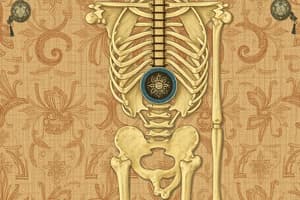Podcast
Questions and Answers
What is a lever?
What is a lever?
A rigid bar that is free to pivot, or rotate, on a fixed point.
What are lever systems?
What are lever systems?
The co-ordination of our bones and muscles, primarily to create human movement.
What are the two main functions of a lever system?
What are the two main functions of a lever system?
To generate muscular effort to overcome a given load and to increase the speed of a given movement.
What are the 4 components of a lever system?
What are the 4 components of a lever system?
What is the lever?
What is the lever?
What is the fulcrum?
What is the fulcrum?
What is the effort?
What is the effort?
What is the load?
What is the load?
What is a first class lever?
What is a first class lever?
What is a second class lever?
What is a second class lever?
What is a third class lever?
What is a third class lever?
What is the effort arm?
What is the effort arm?
What is the resistance (load) arm?
What is the resistance (load) arm?
What is a mechanical advantage?
What is a mechanical advantage?
What is a mechanical disadvantage?
What is a mechanical disadvantage?
What is in the middle of a first class lever?
What is in the middle of a first class lever?
What is in the middle of a second class lever?
What is in the middle of a second class lever?
What is in the middle of a third class lever?
What is in the middle of a third class lever?
Give an example of where there may be more than one lever system operating at a joint.
Give an example of where there may be more than one lever system operating at a joint.
Where are the majority of movements in the human body operated by?
Where are the majority of movements in the human body operated by?
Give an example of a first class lever and define each component in relation to the example.
Give an example of a first class lever and define each component in relation to the example.
Give an example of a second class lever and define each component in relation to the example.
Give an example of a second class lever and define each component in relation to the example.
Flashcards are hidden until you start studying
Study Notes
Lever Basics
- A lever is a rigid bar that pivots on a fixed point known as the fulcrum.
- Lever systems coordinate bones and muscles to facilitate human movement.
Functions of Lever Systems
- Generate muscular effort to overcome loads.
- Increase the speed of movements.
Components of a Lever System
- Four main components: lever (bone), fulcrum (joint), effort (muscular force), and load (weight or resistance).
Diagram Notations
- Lever is represented as a line.
- Fulcrum is represented as a triangle.
- Effort is represented as an arrow.
- Load is represented as an arrow with a square.
Types of Levers
- First Class Lever: Fulcrum is between effort and load.
- Second Class Lever: Load is between effort and fulcrum.
- Third Class Lever: Effort is between load and fulcrum.
Lever Arms
- Effort arm: Distance between the fulcrum and the effort.
- Resistance arm (load arm): Distance between the fulcrum and the load.
Mechanical Advantage and Disadvantage
- Mechanical Advantage: Occurs when the effort arm is longer than the resistance arm, enabling the lever to lift heavy loads.
- Mechanical Disadvantage: Occurs when the resistance arm is longer than the effort arm, allowing for quicker movement.
Lever Class Acronyms
- First class: E F L (Effort-Fulcrum-Load).
- Second class: E L F (Effort-Load-Fulcrum).
- Third class: F E L (Fulcrum-Effort-Load).
Joint Movement Examples
- Flexing the elbow during a bicep curl creates a third class lever system.
- Extending the elbow while throwing a javelin utilizes a first class lever system.
Prevalence of Lever Types
- The majority of movements in the human body are operated by third class levers.
Specific Lever Examples
- First Class Lever Example: Neck extension to head a football.
- Effort: Trapezius muscle
- Fulcrum: Spine
- Load: Weight of the player's head
- Second Class Lever Example: A dancer on tiptoe.
- Effort: Gastrocnemius and soleus muscles
- Fulcrum: Toes (metatarsals)
- Load: Weight of the dancer
Summary of Fulcrum and Lever Relationships
- Joints act as fulcrums, enabling bones (levers) to rotate and create movement through muscular effort.
Studying That Suits You
Use AI to generate personalized quizzes and flashcards to suit your learning preferences.




